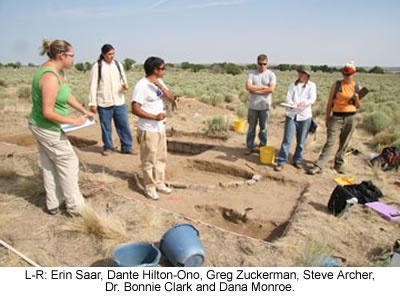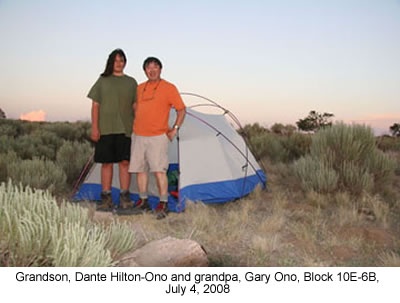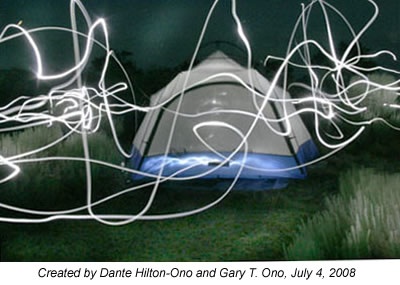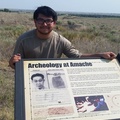I call this hauntingly provocative photograph from my Issei grandmother, Owai Okamura’s photograph album “Amache Night.” This is the only night scene of a War Relocation Authority camp that I’ve ever seen. I believe one of my uncles might have taken this photograph. As a child, I recall photographic printing being developed in the mess hall sink at night.
Amache, one of ten War Relocation Authority prison camps, is located near the town of Granada in the south east corner of Colorado, where my Okamura and Ono families lived during WWII along with thousands of other forcefully evacuated Japanese from California’s Sonoma County, Central Valley and Los Angeles.
65-years later, I had the opportunity to return to Amache as a volunteer with the University of Denver’s Field School in Historical Archaeology & Museum Studies conducted June 16 – July 11, 2008. This archeological program was created and lead by DU Assistant Professor of Anthropology, Dr. Bonnie Clark.
Marie Masumoto, research assistant at the Hirasaki National Resource Center in the Japanese American National Museum, who had taken part in archaeological excavations at the Manzanar National Historical site had been asked by Dr. Clark if she might take part in the Amache project, however she could not. Marie remembered that I was a former Amache internee and ran to fetch me in the Collections department, where I am a volunteer. Marie introduced me to Dr. Clark, who was visiting the National Museum to research and meet with former Amache internees in preparation for her planned archaeological study of Amache. She asked if I might consider joining her project. I volunteered on the spot.
With Dr. Clark’s approval, I asked my 16-year-old grandson, Dante Hilton-Ono if he might be interested. Unhesitatingly, he said yes. We joined program leader, Dr. Bonnie Clark and her six graduate students, an archaeo-botanist, and a museum curator, mid-way in the program on June 30 to assist in their archaeological dig.
Dynamic leader Dr. Clark and her energetic and enthusiastic team members began teaching us archaeological field techniques. We had to perform these tasks in the early mornings because of the sweltering heat. At mid-day, we would head into Granada for lunch and work in the Amache Preservation Society’s air-conditioned museum. Granada High Social Studies teacher, John Hopper co-founded the APS in 1993 with then school superintendent, Ian DeBono and ever since, has been working hard with their student members to preserve the Amache site and history. Amache was recently designated a National Historical Landmark, a status reserved for historical sites of national and international significance.
One of the main research avenues of University of Denver’s Amache project is to reveal and study the garden features of Amache, which Dr. Clark said demonstrate the determination of the internees to improve the denuded and arid environment into which they were placed. The Amache internees, many farmers and gardeners, beautified the camp with Chinese Elm trees, many floral and vegetable gardens. There were also koi ponds discovered in various locations. One, a large pond with a small bridge was near the Amache Town Hall.
The following picture shows Dr. Clark (2nd from right) and archaeo-botanist, Steve Archer (3rd from right). Steve was recruited from the Colonial Williamsburg, Virginia project for his expertise in archaeology of historic gardens. They are talking with the students about the garden feature discovered at the end of Block 9L. This garden spot was referred to by some nearby neighbors as, “Chinatown” because of the youths who hung out, played music and partied there. Because Block 9L jutted out on the eastern edge of Amache, it afforded them a bit of privacy. Behind the group in the picture shows roughly the view of the open farmland field enjoyed by the “Chinatown” revelers.
One of the students, Dana Ogo Shew had families who were interned in Topaz, Utah during WWII (Ogo and Hamasaki families). This in part was extra motivation for her on this Amache archeological dig. Her Master’s thesis will focus on the lives of women in camp. She will want to talk to as many female former internees as possible. She may be contacted at doshew@yahoo.com
Another graduate student, April Kamp-Whittaker is focusing on childhood in the camp. I witnessed her delight at discovering marbles throughout Amache. She too would be interested in former internees who remember what it was like to be a child in camp. She may be contacted at akampwhi@du.edu - Please help them to produce a meaningful and comprehensive studies.
Just before sunset, on the clear summer afternoon of July 4, 2008, my grandson, Dante and I pitched a tent within the crumbling foundation that outlines Barrack 6, Block 10E, precisely where our families had lived and slept over sixty-years-ago. We were given permission to spend the night on-site while the rest of the University of Denver crew returned to Denver to host a DU museum reception for conferees attending the Japanese American National Museum’s 3rd National Conference, themed “Whose America? Who’s American? Diversity, Civil Liberties, and Social Justice.” The theme is so fitting for the Fourth of July weekend conference.
This could not be compared to sleeping in the Lincoln bedroom in the White House, because no politically connected VIP slept here in Amache. Only the helpless victims of racism, economic opportunism, and war hysteria rested their weary heads here. Nonetheless, Amache is a site of historical importance, even if a president didn’t sleep here.
My grandson helped me create a contemporary photograph along the line of “Amache Night.” We experimented with Dante shining a flashlight inside the tent and then outside the tent, while I kept the camera shutter open. Dante got caught up in the excitement and after many takes, we agreed that this was the picture we liked. Not quite as haunting as “Amache Night,” but definitely provocative, our very own little fireworks celebration.
Choosing to do this on the night of America’s annual celebration of independence, the Fourth of July, filled us with a strong sense of irony. We imagined what it must have felt like to be imprisoned while the rest of America celebrated their independence and freedom. Perhaps, they even imagined seeing and hearing the far-off fireworks celebration in the nearby towns beyond and outside of the barbed wire fence and six guard towers that surrounded them. That was their haunting “Amache Night.”
* More information about the DU Amache Research Project can be found at: http://portfolio.du.edu/amache.
© 2008 Gary T. Ono











